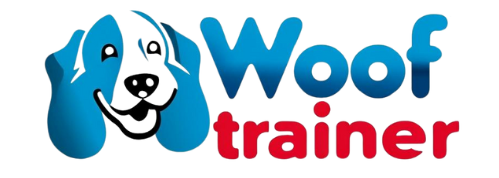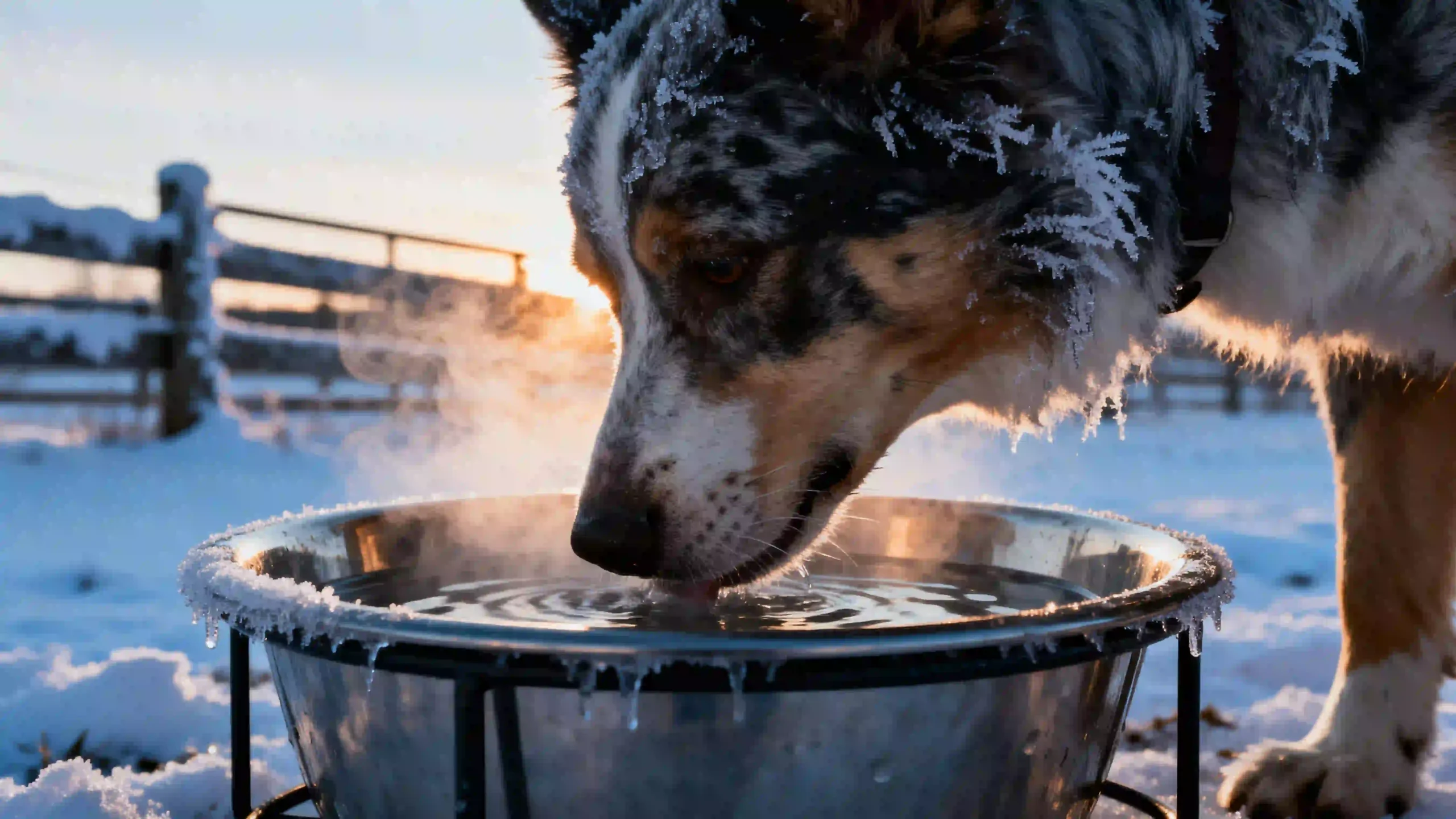You keep dogs outdoors all year. You know: when winter hits hard, hydration becomes more than “nice to have”—it’s essential for your working dogs’ health, safety, and performance. Farm dog hydration winter isn’t just about pouring water; it’s about preventing dehydration in freezing temps, managing frozen water risk, and ensuring outdoor dog safety with durable heated bowl solutions. This guide is built for you—farmers & ranchers raising sheepdogs, guard dogs, cattle dogs in extreme weather, who want reliability and minimal extra labor.
Hydration Risks in Winter & Why Ordinary Setups Fall Short
When temperatures drop below freezing, ordinary water bowls freeze, even when partially sheltered. Once the water surface freezes—or is covered by ice—you suddenly have no usable water. That’s the frozen water risk.
Even water that is just a degree or two above zero can feel slick or unpalatable to dogs; they tend to drink less. Reduced intake means dehydration, which can reduce their ability to maintain body heat, slow recovery after work, reduce digestion and immune function.
Outdoor dog safety is compromised when dehydration combines with cold: frostbite, hypothermia, sluggishness in rounding stock, or guarding. If you delay or skimp on winter hydration, costs show up in vet bills, reduced performance, or worse.
What Makes a Heated Bowl Truly Farm-Grade
You already know there are bowls labeled “heated,” but many fail under real farm conditions. Here’s what you need—and what too many products leave out.
| Feature | What to insist on | Why it matters under farm / winter conditions |
|---|---|---|
| Verified performance at very low temps | Look for specs showing water remains thawed at −15°C, −20°C, or lower. | Without this, bowls may freeze solid overnight despite being “heated.” |
| Strong heating power + thermostat control | Enough wattage so heating element engages when needed but shuts off to conserve power and avoid overheating. | Prevents burnout of units or overuse of electricity. |
| Rugged build: stainless steel, chew-resistant cord, anti-tip base | Durable materials and design that survive kicks, tipping, and chewing. | Saves you from replacing units mid-season. |
| Safe power design | Low voltage or well-insulated wiring, protection from moisture; GFCI circuits. | Reduces risk of electrical shock, shorting, or fire. |
| Easy cleaning & hygiene | Stainless steel or easily cleanable plastics; accessible shapes; minimal crevices. | Dirty, iced bowls discourage drinking and raise infection risk. |
Example of a Top-Tier Heated Bowl
To illustrate what “farm-proof” looks like in real life:
- The WoofTrainer Heated Dog Bowl is built for harsh winter use: made with food-grade 18/8 stainless steel, 30 cm diameter × 10 cm high.
- It runs on 24V low-voltage supply, which lowers risk of shock both for dogs and for you.
- Its heating element is 50W, which maintains water in the 0°C to 20°C range even when the ambient temperature drops to −20°C.
- Cord is 1.3 meters long, wrapped in chew-resistant stainless steel, and the base has a rubber ring to prevent tipping over.
Using a bowl like this means fewer times you have to break ice, refill, or repair damage. It’s a practical, heavy‐duty hydration solution for both dogs and livestock alike.
Matching Heated Bowls to Different Scenarios
Which bowl is right depends on how you use it. Here are use-case-based recommendations:
| Scenario | What you need | Example / Standards to look for |
|---|---|---|
| Guard dogs on fences / perimeter lines | Remote placement; long power runs or solar with backup; big enough bowl so dogs always find drinkable water. | Anti-tip base; insulated cords; performance confirmed below −10°C. See Best Heated Dog Bowls for Guard Dogs in Extreme Weather. |
| Dogs in barnyards and high-traffic areas | Extra durable surfaces, easy to clean, protected from feed, mud, livestock brushes. | Stainless steel; large capacity; spill-resistant design; cords routed away from traffic. |
| Working dogs in open fields or paddocks | Portable or multiple bowls; perhaps solar or battery-assisted; redundancy across resting areas. | Several smaller heated units or portable heavy-duty bowls; ensure each unit meets safety and heating specs for extreme cold. |
Also consider capacity: big enough that it doesn’t freeze solid overnight, but manageable so water doesn’t stagnate. Otherwise, large bowls are good—but larger water volume means more heat needed to keep from freezing.
Installation, Maintenance & Practical Tips to Reduce Labor
You’re aiming for minimal labor while ensuring your dogs always have non-frozen water. These are tips that often are not detailed enough in general guides—but make all the difference:
1.Shelter and placement
- Put your heated bowl under cover—barn eaves, lean-tos, or windbreaks—to reduce wind chill and snow buildup.
- Elevate the bowl slightly so snow or slush doesn’t cover it; base should stay level and stable.
2.Protect your power source
- Use low-voltage (or properly insulated wiring), GFCI-protected circuits.
- Secure cords: chew-resistant wrapping or protective conduit. Dogs or livestock will test anything that smells or looks chewable.
- Where possible, bury or route cords out of reach of stomps or freezing water.
3.Check temperature and level frequently in severe cold
- Even with heating, thin ice can form if water is low or element is partially blocked. Two checks per day when it’s −10°C or colder are a good practice.
- Ensure water covers the heating area properly; running heating element dry damages it.
4.Cleaning matters
- Use stainless steel if you want faster, safer cleaning. Slime, algae, feed residue reduce water taste and may discourage drinking.
- In winter, use a brush to clean edges; drain and refill completely to avoid buildup under ice.
5.Backup plans
- Keep spare bowls; have manual buckets available. If heated bowl fails—power outage, wire damage—you still have water.
- Solar + battery options are good for remote pens but always check that components are rated for extreme cold.
What Has Often Been Overlooked, & How to Avoid Pitfalls
When you read heating bowl guides or ads, many omit or underplay things that matter on a working farm. Here’s what to watch out for—translated into action-items:
- Products that don’t list cold performance: If a bowl says “works below freezing” but doesn’t state the specific temperature, assume modest performance. Better to pick one with tested data (e.g. keeps water above 0°C at −20°C like the WoofTrainer does).
- Bowls with weak wattage or inadequate thermostat control: These may freeze, or run so hot they damage cord insulation.
- Thin or non-insulated bases: Cold ground draws heat; water near base freezes first. Look for insulation or base design that reduces heat loss.
- Cheap plastic bowls: Some are brittle in cold, crack, or become unsafe. Stainless steel is heavier, more durable, less likely to hold odors or leach chemicals.
- Poor cord protection: Chewing, wetness, frostbite risk; water and snow exposure demands strong cord insulation and protection.
Choosing Between Products & What to Budget For
When you shop, here’s a checklist and budgeting guide to decide what you’re willing to pay—and what you get in return.
- Price vs durability: Better stainless steel + high wattage + safety features cost more, but save money over years in fewer replacements, less vet work.
- Operating cost: 50W continuous heating in winter will use electricity; figure your rates locally. Compare that to cost of lost performance or labor time you spend thawing frozen bowls.
- Warranty & parts: Heating elements fail; cord insulation wears; anti-tip bases may crack. Good manufacturers offer repairable parts, replaceable cords, good warranties.
For guard dogs, size, durability, safety are non-negotiable. You’ll want something equivalent in spec to Why Heated Water Bowls Are a Breeder’s Best Friend in Winter in terms of hygiene and safe, constant hydration.
FAQ
-
How cold can a good heated bowl realistically handle?
A robust heated bowl (e.g. 50W stainless steel with good insulation) should keep water above freezing down to −15°C to −20°C. Anything less in spec means risk of freezing or partial ice forming overnight. -
Is cold water sometimes okay, or do dogs refuse very cold water?
Many dogs actually prefer cooler water. But when water is icy, frozen, or hard to access, they’ll drink far less. The goal is drinkable, unfrozen water—not to force warmth, but to eliminate frozen barriers to drinking. -
Can electricity be a liability outdoors in winter?
Yes—if wiring, plugs, cords are exposed, damaged, or poorly insulated. That’s why low-voltage designs, proper safety listings, moisture-sealed elements, protected cords are essential. Always use GFCI or its equivalent for outdoor circuits. -
What about backup when power fails or in remote pens?
Solar heating with battery backup helps, or manual supply (frequently breaking ice, carrying water). But solar power tends to underperform in overcast, short-day winter conditions. Always have a manual fallback. -
How big should the bowl be for multiple working dogs / livestock sharing?
Enough to supply all drinking needs between your refill/check-ins without freezing. For two or more dogs + occasional cattle access, a larger diameter stainless steel bowl, or multiple units. Depth helps, but too shallow means faster freezing at surface. -
How often do I really need to clean a heated bowl in winter?
At least daily cleaning of drinking area and rim; full drain & scrub every few days if feed or mud contaminates; weekly full sanitizing if bacteria risk is high. Dirty or icy bowls reduce intake and can cause infections. -
Is the added cost of a high-quality heated bowl justified?
Yes—for working, performance dogs. Consider cost of vet bills from dehydration, drop in working ability, time spent breaking ice or replacing cheap failures. A well-built bowl often pays for itself via reduced labor, fewer emergencies, and maintaining dog health.
You may also want more deep info:
Heated Dog Bowls for Farm Dogs: What You Need to Know
Best Heated Dog Bowls for Guard Dogs in Extreme Weather


